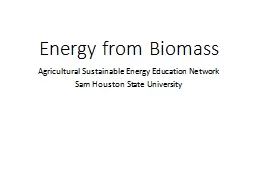PPT-Second Generation Biofuels in India – Relevance and Statu
Author : pamella-moone | Published Date : 2017-04-27
Narasimhan Santhanam Energy Alternatives India EAI About EAI Leading Indian renewable energy business intelligence market strategy consulting firm Work on all
Presentation Embed Code
Download Presentation
Download Presentation The PPT/PDF document "Second Generation Biofuels in India – ..." is the property of its rightful owner. Permission is granted to download and print the materials on this website for personal, non-commercial use only, and to display it on your personal computer provided you do not modify the materials and that you retain all copyright notices contained in the materials. By downloading content from our website, you accept the terms of this agreement.
Second Generation Biofuels in India – Relevance and Statu: Transcript
Download Rules Of Document
"Second Generation Biofuels in India – Relevance and Statu"The content belongs to its owner. You may download and print it for personal use, without modification, and keep all copyright notices. By downloading, you agree to these terms.
Related Documents














